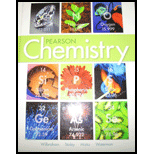
(a)
Interpretation: The name of the given acid should be determined.
Concept Introduction: Acids are substances that can donate
(a)
Answer to Problem 73A
The name of the given acid is hydrochloric acid.
Explanation of Solution
The acid is comprised of hydrogen and chlorine, so the name of these elements is written followed by the suffix ‘acid’.
(b)
Interpretation: The name of the given acid should be determined.
Concept Introduction: Acids are substances that can donate
(b)
Answer to Problem 73A
The name of the given acid is nitric acid.
Explanation of Solution
The acid is comprised of hydrogen ions and the nitrate ion, so the name of the acid is written by adding the ending ‘-ic’ to the root name nitrate by replacing the ‘e’. The suffix acid is also added.
(c)
Interpretation: The formula of the given acid should be determined.
Concept Introduction: Acids are substances that can donate
(c)
Answer to Problem 73A
Sulfuric acid can be chemically represented as
Explanation of Solution
Sulfuric acid contains sulfate ions and two hydrogen ions, hence the formula is
(d)
Interpretation: The formula of the given acid should be determined.
Concept Introduction: Acids are substances that can donate
(d)
Answer to Problem 73A
The chemical formula of acetic acid is
Explanation of Solution
Acetic acid is a
Chapter 9 Solutions
Chemistry 2012 Student Edition (hard Cover) Grade 11
- In the normal hydrogen electrode, the current flows through the electrode when the power difference of the interface is +5 mV. Calculate the overvoltage n at pH = 2, if the equilibrium potential is -0.118 V.arrow_forwardIn the normal hydrogen electrode, the balance potential difference in the interface is 0 and the current flow across the electrode when the interface potential difference is +5 mV. Explain briefly. Is the overvoltage 5 mV?arrow_forwardIn the normal hydrogen electrode, the balance potential difference in the interface is 0 mV, the maximum potential is 5 mV. Explain briefly.arrow_forward
- utron eutro cle TH tro (Na (b) Atoms are said to be electrically neutral. Explain. (c) Distinguish between the following: (i) Atomic number and mass number. (ii) Mass number and relative atomic mass. 2. An isotope Q, has 18 neutrons a mass number of 34. (a) (i) Draw the atomic structure of Q. (ii) Write its electron arrangement (b) To which period and group does Q belong? Explain your answer. (c) How does Q form its ion? Explain. 3. (a) Determine the relative atomic mass of the following elements = compositions occur in the proportions given. (i) Neon 20 21 22. Ne (90.92%), 10Ne (0.26%), and 10Ne (8.82%) (ii) Argon 36 38 40 18 Ar (0.34%), 18 Ar (0.06%) and 18 Ar (99.6%)arrow_forwardIn the normal hydrogen electrode, the balance potential difference in the interface is this, the maximum potential is 5 mV. Explain briefly.arrow_forwardThe electrode balance potential is -0.118 V and the interface potential difference is +5 mV. The overvoltage n will be 0.005 - (-0.118) = 0.123 V. Is it correct?arrow_forward
- In the electrode Pt, H2(1 atm) | H+(a=1), if the electrode balance potential is -0.118 V and the interface potential difference is +5 mV. The current voltage will be 0.005 - (-0.118) = 0.123 V ¿Correcto?arrow_forwardIn the electrode Pt, H2(1 atm) | H+(a=1) at 298K is 0.79 mA cm-2. If the balance potential of the electrode is -0.118 V and the potential difference of the interface is +5 mV. Determine its potential.arrow_forwardIn one electrode: Pt, H2(1 atm) | H+(a=1), the interchange current density at 298K is 0.79 mA·cm-2. If the voltage difference of the interface is +5 mV. What will be the correct intensity at pH = 2?. Maximum transfer voltage and beta = 0.5.arrow_forward
- In a Pt electrode, H2(1 atm) | H+(a=1), the interchange current density of an electrode is 0.79 mA cm-2. ¿Qué corriente flow across the electrode of área 5 cm2 when the difference in potential of the interface is +5 mV?.arrow_forwardIf the current voltage is n = 0.14 V, indicate which of the 2 voltage formulas of the ley of Tafel must be applied i a a) == exp (1-B). xp[(1 - ß³): Fn Fn a b) == exp B RT RTarrow_forwardIf the current voltage is n = 0.14 V. Indicate which of the 2 formulas must be applied a) = a T = i exp[(1 - p) F Fn Fn b) i==exp B RTarrow_forward
 ChemistryChemistryISBN:9781305957404Author:Steven S. Zumdahl, Susan A. Zumdahl, Donald J. DeCostePublisher:Cengage Learning
ChemistryChemistryISBN:9781305957404Author:Steven S. Zumdahl, Susan A. Zumdahl, Donald J. DeCostePublisher:Cengage Learning ChemistryChemistryISBN:9781259911156Author:Raymond Chang Dr., Jason Overby ProfessorPublisher:McGraw-Hill Education
ChemistryChemistryISBN:9781259911156Author:Raymond Chang Dr., Jason Overby ProfessorPublisher:McGraw-Hill Education Principles of Instrumental AnalysisChemistryISBN:9781305577213Author:Douglas A. Skoog, F. James Holler, Stanley R. CrouchPublisher:Cengage Learning
Principles of Instrumental AnalysisChemistryISBN:9781305577213Author:Douglas A. Skoog, F. James Holler, Stanley R. CrouchPublisher:Cengage Learning Organic ChemistryChemistryISBN:9780078021558Author:Janice Gorzynski Smith Dr.Publisher:McGraw-Hill Education
Organic ChemistryChemistryISBN:9780078021558Author:Janice Gorzynski Smith Dr.Publisher:McGraw-Hill Education Chemistry: Principles and ReactionsChemistryISBN:9781305079373Author:William L. Masterton, Cecile N. HurleyPublisher:Cengage Learning
Chemistry: Principles and ReactionsChemistryISBN:9781305079373Author:William L. Masterton, Cecile N. HurleyPublisher:Cengage Learning Elementary Principles of Chemical Processes, Bind...ChemistryISBN:9781118431221Author:Richard M. Felder, Ronald W. Rousseau, Lisa G. BullardPublisher:WILEY
Elementary Principles of Chemical Processes, Bind...ChemistryISBN:9781118431221Author:Richard M. Felder, Ronald W. Rousseau, Lisa G. BullardPublisher:WILEY





